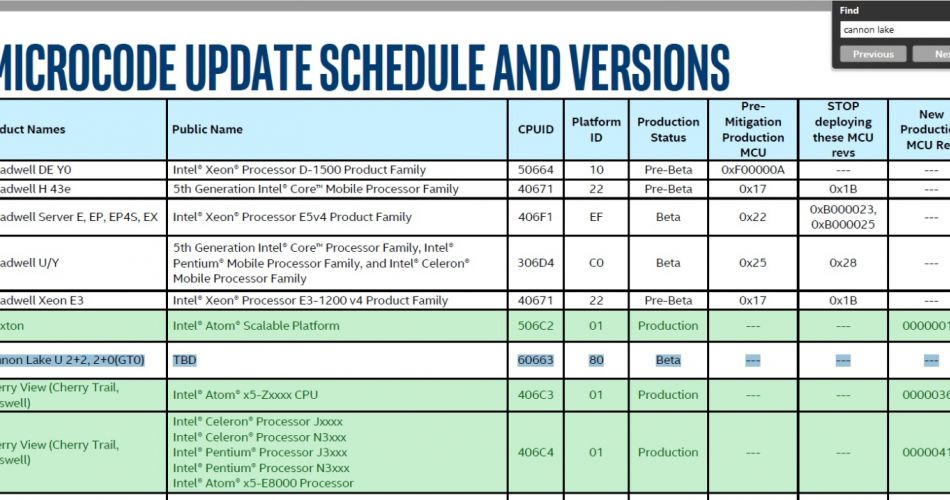Intel Docs Confirm Dual-Core Cannon Lake CPUs With And Without iGPUs

It seems Intel did, technically, ship 10nm parts in 2017. The existence of in-production dual-core Cannon Lake CPUs with and without integrated graphics has been confirmed by a publicly released Intel document.
Intel chose not to mention Cannon Lake or its long-in-development 10nm process at its CES 2018 keynote. Instead, it quietly confirmed at a press-only event the following morning that Cannon Lake CPUs had actually been shipped in 2017. Rumors suggested that these were low-power, dual-core parts that were possibly lacking integrated graphics.
Those rumors have been seemingly confirmed by Intel’s Spectre microcode guidance document (pictured above), which was released on February 8 with Intel’s Spectre patching update (the document was updated on February 12 and the above has been removed). Two Cannon Lake “U” CPUs have been listed. The “U” designation, which has been used for mobile Core CPUs with a 15W TDP since at least the 5th generation, suggests that these parts are also low-power mobile parts. The “2+2” denotes that one CPU has two CPU cores and a GT2 iGPU. This would put the chip in the same market segment as mobile Core i3 CPUs, such as the i3-8130U.
The “2+0(GT0)” denotes that the second CPU has two CPU cores and no iGPU. This is interesting because it means that the CPU can’t function as a notebook part. In theory, it could be paired with a low-power discrete GPU, such as an Nvidia MX130, but that would negate much of the power savings from the CPU while not offering anything for applications without GPU acceleration. Even most embedded devices, like NASes and Intel NUCs, need graphics, so it’s difficult to think of an application for this chip.
Intel has been talking about 10nm for a very long time, but it always seems to be perpetually on the horizon. There were even rumors that Cannon Lake isn’t production-worthy, so it wouldn’t be productized. A pair of small CPUs, one of which might have a disabled (as opposed to unfabricated) GPU section, doesn’t inspire confidence in Intel’s 10nm process’ early yield, even if it does confirm Intel’s promise of shipping 10nm parts in 2017. The most recent update we got on the process was in the company’s Q4 2017 financial report. Krzanich said that low-volume 10nm production would continue for the first half of 2018, before shifting to high-volume production.